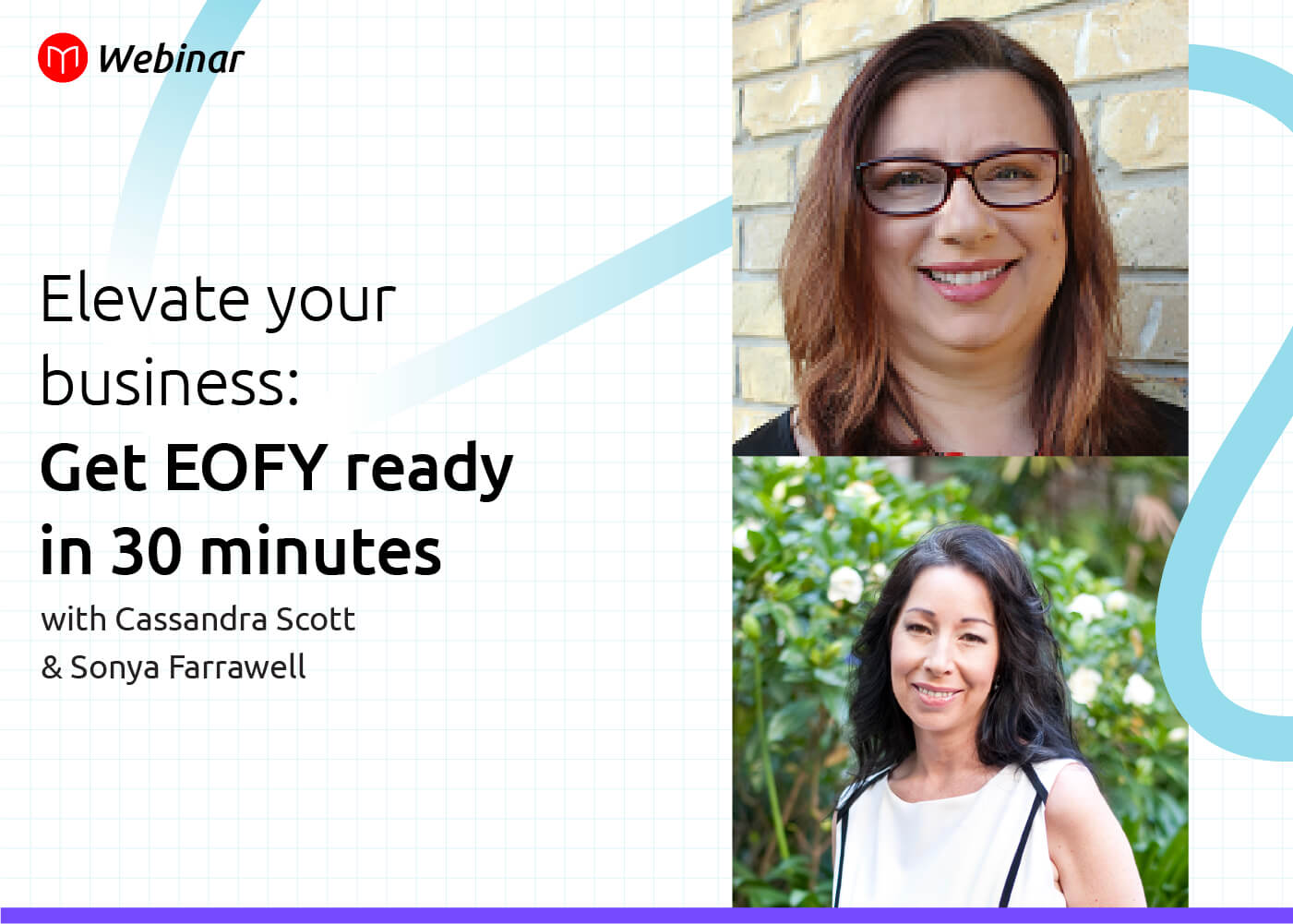In our latest webinar we asked two Directors of Australia's leading bookkeeping association (ABA), Cassandra Scott and Sonya Farrawell, for some of their top tips on how to settle the EOFY nerves and get ahead during the financial-year-end period.
Together, they have more than 50 years of experience in financial services and business support, and were extremely generous with their time and insights.
We've summarised the key takeaway's for you to read through or you can watch the full webinar below.
Time Management
👉 Stop putting things off, the best time to get started with planning is now!
Checklists can be a great help. Cassandra and Sonya are both impressed with this one from the WA government.
With changes to Superannuation Guarantee and STP Phase 2.0 coming into place it’s important to start ensuring you have all required information available, have had all necessary conversations and have taken all the necessary steps to ensure you’re compliant.
“It’s a matter of making a list, scheduling it into timelines and taking a methodical approach” says Sonya. “It’s also going to be really important to make sure you’ll have all the correct information from your employees, because you’ll need all that information for processing at EOFY.”
A sentiment echoed by Cassandra: “With the further evaluation of STP, it’ll just mean that in the future payroll won’t be able to be processed without those critical pieces of data. It’ll be about regulating the information collected by businesses.”
Reconciliations
👉 Payroll reconcilliations should be an ongoing process throughout the year, not left until EOFY.
Historically, payroll reconciliations weren’t done until EOFY, but these days payroll reconciliations should be an ongoing process - undertaken at a minimum when IAS lodgements (Installment Activity Statement) are undertaken.
If you are waiting until EOFY to reconcile your payroll, you should probably rethink that process.
Cassandra shared her process around reconciling: “We start with the Payroll Activity Summary Report, a summary of everything that has been processed through payroll. We then compare that report to the general ledger reports for each of the respective accounts: the wages expense accounts, the super expense accounts, the superannuation liability accounts, the PAYGW liability accounts…and we’re confirming that there’s a correlation of data between the summary report and the accounting data.”
“We then start to look for any variances that are there. It could be something as simple as an employee reimbursement or a stationary expense. These sorts of things should be identified early on in the reconciliation, so they’re cleaned up before you get to June 30th.”
“We’re also confirming what’s been lodged with the ATO. Things can go wrong throughout the year, a back pay or a payroll might be processed that wasn’t picked up. So it’s good to check if those things correlate as well - because if it doesn’t it will probably be picked up years later down the track. And you don’t want to be stuck with it then!”
Policies and Procedures
👉 Ensure you are have the right payroll policies and procedures in place to ensure you are meeting your legal obligations, especially surrounding confidentiality and security of payroll records.
Policies and procedures in larger organisations tend to be taken care of as a matter of course - but many small businesses tend to overlook them since management is often more involved in the day-to-day of the business. Nevertheless, all organizations must make sure they meet all legal obligations in relation to (payroll) processes.
"A key consideration in relation to policy and procedural requirements is the security and confidentiality of payroll records. This information cannot be released to third parties without the employees authorisation. It is important to have an established chain of command, clear delegation of payroll responsibilities as this will assist with minimising security breaches." says Sonya.
Talking to your bookkeeper or accountant can be a great place to start. The community of bookkeeping professionals and accountants is very active and information gets shared fast with a high degree of professionalism, so they're your best place to find all the most up to date information.
Reportable Fringe Benefit Amounts
👉 There can be confusion surrounding this area. RFBA are not taxable and do not recieve Super.
While the FBT (Fringe Benefit Tax) year runs from April 1 to March 31 every year, we often field questions about fringe benefits at EOFY.
“A few things to keep in mind is that Reportable Fringe Benefits Amount (RFBA) is not taxable, it doesn’t receive super. It’s not a financial transaction for payroll, it's simply a reporting mechanism.” says Sonya.
“And, something I often see some confusion about, regardless of the type of benefit, on the Income Statement the RFBA is calculated using the Type 2 gross-up rate which is 1.8868.”
(E.g. If an employee receives certain fringe benefits with a total taxable value of $2,000.01 for the FBT year ending 31 March 2022, the reportable fringe benefits amount is $3,773).
“Another important thing to remember is, if the total taxable value is of $2k or under, it is not reportable.”
If you’re ever unsure about RFBA though - reach out to your Tax Agent to provide you the support and services that you need. They’re the best person to help with any questions on this topic.
Superannuation
👉 To prevent complications ensure super contributions are timed correctly, know your super clearing deadlines and how long processing will take.
There are a few things that are worth considering with superannuation, and it often comes down to the fact that employees want to make sure they get the maximum super contributions made in the right time.
“Timing deadlines of SG clearing houses is one of those things,” says Cassandra “if you make a payment on the 30th of June it won’t make this year's cut off. So check with your provider how long processing would take.”
“And if this means EOFY top up contributions are needed to be made earlier than usual, make sure you have those conversations with relevant people - because you obviously want to ensure there is no mix up with their personal contributions.”
Lastly there’s the upcoming changes to SG threshold and the SG rise from 10% to 10.5% - it’s important to find out from your payroll provider if these will be updated automatically (they will in Microkeeper) or if you need to be manually involved in the change.
STP
👉 Make sure you are up to speed with changes to STP - seek expert assistance if required.
Finally, there’s upcoming changes to Single Touch Payroll that are significant. For small businesses it might be worthwhile outsourcing some of it to specialists in the field.
But if you want to continue doing things on your own there are significant resources created by the many payroll products in the market. (Our STP 2.0 updates can be found here)
Whether or not the ATO will be punitive during the first 12 to 24 months is still a guess. “We like to think that they wouldn’t be, but it’s probably safest to be prepared now.” agree, both Sonya and Cassandra.
It might be time to change payroll software and/or your employee onboarding processes, because in the future you might actually not be able to pay staff if the correct information isn’t collected and reported with STP.
Conclusion
👉 Breathe in. Breathe out. You got this.
While EOFY can be a bit of a nervous time for business owners, bookkeepers, and many people in accounting departments across the country - with a bit of organisation there’s really nothing to be worried about.
Get those checklists out, keep an eye on the resources that are shared by your payroll provider, and when in doubt - talk to a professional.



.jpg)